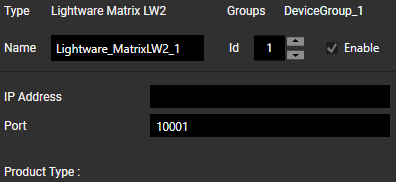Loading...
The Lightware LW2 Device in the Configuration dialog allows to easily remote control different functions of a Lightware device e.g. a matrix. Widget Designer uses the LW2 protocol which was developed by Lightware Visual Engineering and is present in their video signal management equipment per default. Note that the device is only available in the licensed Widget Designer edition, not the Free version.
To add a Lightware LW2 device, open the Devices menu and select "Lightware > Matrix LW2 > Create Matrix LW2". This will open the Configuration dialog. Alternatively, you can add a new device in the Configuration dialog with the "+" button when the dialog is already open.
On the right side you see several options:

The Type informs you about the type of device or connection.
The Groups lists the groups to which this device belongs.
The Name is the unique identifier for this Lightware object in WD and the general rules for naming objects apply here as well: only letters, numbers and underscores are allowed; the first symbol must be a letter.
It is possible to change the default name to a more descriptive one. When scripting, enter this Name to access available members or use the Project object and device Type instead; examples are shown further down.
The Id offers an alternative way to address the device when scripting.
The "Enable" check box is selected by default. On the left side, you should later see that the icon in front of your Lightware device is a filled blue circle. An empty blue circle indicates an enabled device where the IP address is not available. A filled gray circle indicates a disabled device.
Now, please enter the IP address of the Lightware device. If needed, adjust the Port. Click the "Apply" button to save any changes done here. The shortcut [Ctrl + Enter] can also be used to apply changes.
If the connection is successful, the Product Type shows to which device you are connected, e.g. "MX8x8DVI Frame".
Once the settings are applied, the dialog can be closed. The newly created device will also be added to the Devices menu > Lightware > Matrix LW2 and can be opened from here or with the Devices menu > Configuration.
As soon as a device is created, it can be addressed via scripting to perform actions on the device as well as retrieve information from it.
To send commands to the device, create a CustomScript button or anything with a scripting field. Enter the device's identifier name into the script field (per default that is "Lightware_MatrixLW2_1") and Script Assist will offer a list of all Lightware Matrix LW2 Members.
You can for example route a source to a target signal:
Lightware_MatrixLW2_1.Route(2,1)
You can also retrieve information via scripting:
vstring = Lightware_MatrixLW2_1.GetLastMessageReceived
Note that this recalls the last message any time the command is executed. It is also possible to execute a script automatically whenever a new message is received. To accomplish this, use an Event Listener as explained below.
As an alternative to explicitly naming the device, the "Project" object can be used. Choose the device type and address the device by entering its ID or name. Script Assist then offers you the same list of members. This is the alternative for the first example from above:
Project.Lightware_MatrixLW2(1).Route(2,1)
Substituting the ID with a dynamic variable allows automation. Actions can be performed on many connections of the same type simultaneously, e.g. by using for-loops:
For i = 1 to 10 {
Project.Lightware_MatrixLW2(i).Route(2,1)
}
The chapter "Project and Context Member" shows more examples with for-loops and if-clauses; of course, normal variables can also be used.
Event Listeners can be added in the Configuration dialog and provide a simple way of listening to triggers from connected devices.
Please see the chapter Event Listener and Group Event Listener for a detailed description of its functionality and Jog/Shuttle Events for an overview (with examples and description) over the events raised by this device.